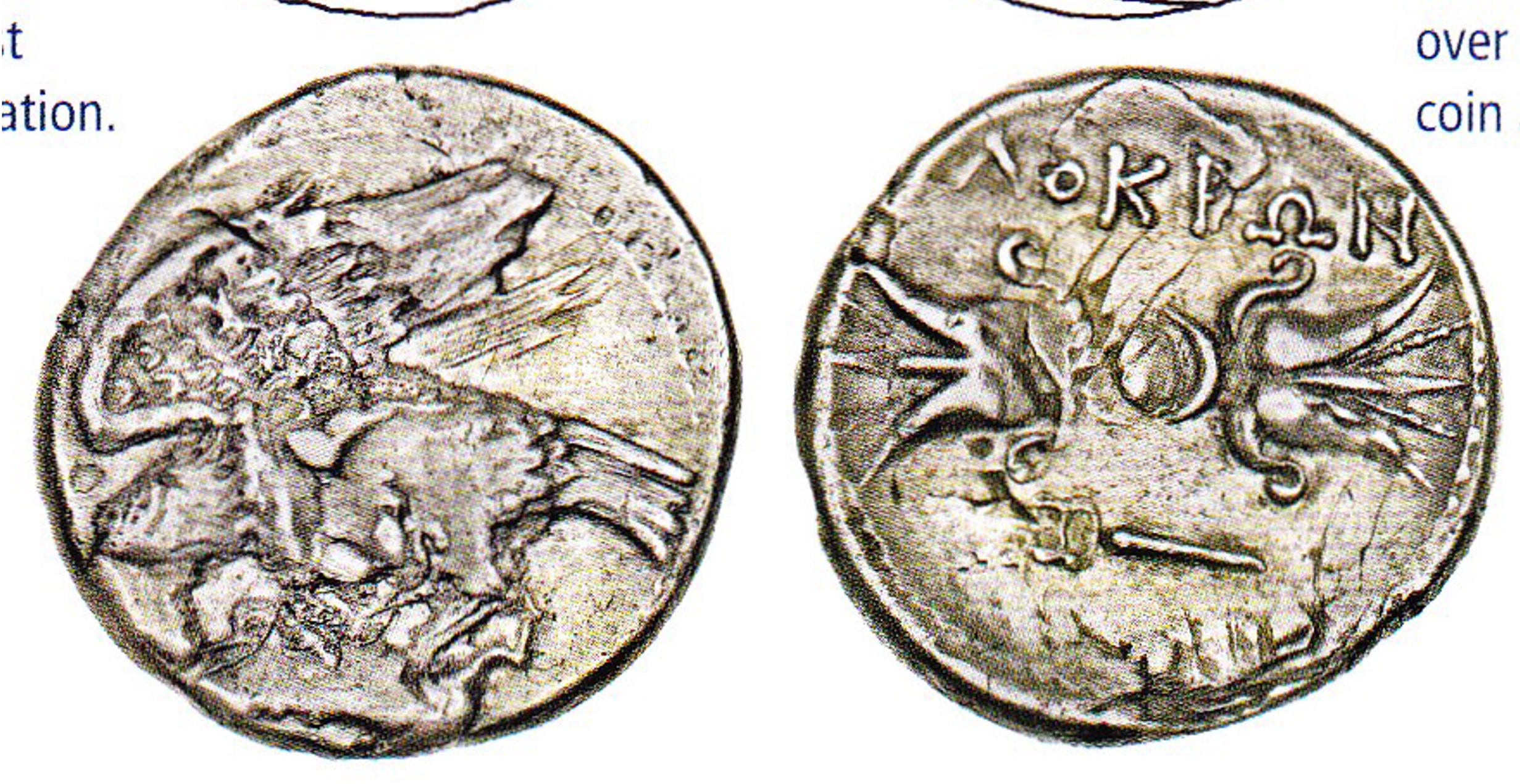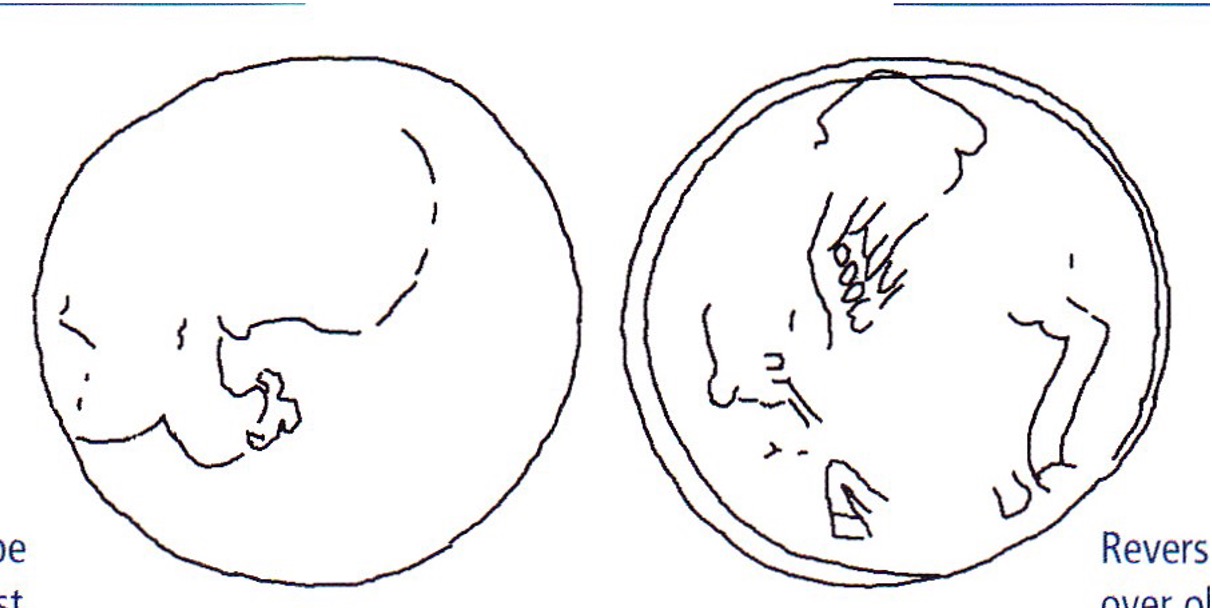398 BCE - 300 BCE | ΛΟΚΡΩΝ
Overstriking coin
SO 1409 - Locri Epizephyrii over uncertain mint.jpg
Overstruck variety
Corinth (head l.).jpg

1409 Corinthian-type (drawing).jpg
Description
| ObverseInscription or printing placed on the obverse.:
|
Eagle flying left, hare in talons.
|
ReverseInscription or printing placed on the reverse.:
|
ΛΟΚΡΩΝ (Greek) Winged thunderbolt and caduceus.
|
Mint and issuing power
| MintIdentifies the place of manufacture or issue of a numismatic object.:
|
Locri Epizephyrii
|
Ancient regionAncient region.
|
Bruttium
|
Modern countryModern country: Italy
|
AuthorityIdentifies the issuing power. The authority can be "pretended" when the name or the portrait of X is on the coin but he/she was not the issuing power. It can also be "uncertain" when there is no mention of X on the coin but he/she was the issuing power according to the historical sources:
|
|
Chronology
| FromIdentifies the initial date in a range assigned in a numismatic context. 398 BCE toIdentifies the final date in a range assigned in a numismatic context.. 300 BCE
|
Classical 480-323 BC  periodTime period of the numismatic object. periodTime period of the numismatic object.
|
Physical description
MetalThe physical material (usually metal) from which an object is made.: Silver 
|
WeightWeight of the numismatic object (in grams). in grams: 7.487.48 g <br />7,480 mg <br />
|
DenominationTerm indicating the value of a numismatic object. Examples: tetradrachm, chalkous, denarius.: nomos
|
AxisDescribes the directional relationship between the obverse and reverse of a numismatic object.: 88 mm <br />0.8 cm <br />
|
|
|
StandardStandard.: Achaian
|
References
| Coin referenceReference of the Coin:
|
MacDonald 2002, p. 64, MacDonald 2009, p. 41, n° 29
|
Coin series referenceReference to coin series study:
|
MacDonald 20021MacDonald 2002, p. 64, MacDonald 20092MacDonald 2009, p. 41, n° 29, HN Italy3HN Italy, n° 2313-2317, HGC 14HGC 1, n° 1566
|
| Coin series web referenceCoin series web references:
|
|
Description
| ObverseInscription or printing placed on the obverse.:
|
Pegasus flying left. Below, mint-mark (visible on reverse: part of wing, rear legs of Pegasus. Irrelevant flan lamination).
|
ReverseInscription or printing placed on the reverse.:
|
Head of Aphrodite left, weraing Corinthian helmet. Behind, probably symbol (visible on obverse: outline of helmet, tail of helmet, and locks of hair, slightly double-struck).
|
Mint and issuing power
| MintIdentifies the place of manufacture or issue of a numismatic object. ᵖ:
|
Corinth
|
Ancient regionAncient region. ᵖ
|
Peloponnesus
|
Modern countryModern country: Greece
|
AuthorityIdentifies the authority in whose name (explicitly or implicitly) a numismatic object was issued. ᵖ:
|
|
Chronology
| FromIdentifies the initial date in a range assigned in a numismatic context. 410 BCE toIdentifies the final date in a range assigned in a numismatic context.. 350 BCE
|
Classical 480-323 BC  periodTime period of the numismatic object. periodTime period of the numismatic object.
|
Physical description
| DenominationTerm indicating the value of a numismatic object. Examples: tetradrachm, chalkous, denarius. ᵖ:
|
stater 
|
|
|
References
References
- ^ MacDonald, David (2002), "Sicilian and Southern Italian overstrikes over Pegasoi," Nomismatika Chronika 21, p. 55-64.
- ^ Macdonald, David (2009), Overstruck Greek coins: studies in Greek chronology and monetary theory, Whitman Publishing, Atlanta.
- ^ Rutter N. Keith et alii (eds.) (2001), Historia Numorum Italy, London, xvi, 223 p., 43 pl.
- ^ Hoover, Oliver D. (2018), The Handbook of Greek Coinage Series, Volume 1. Handbook of Coins of Italy and Magna Graecia, Sixth to First Centuries BC., Lancaster-London, 2018, lxi, 527 pages, 23 cm
- ^ Calciati, Romolo (1990), Pegasi, Mortara, Edizioni I.P..


